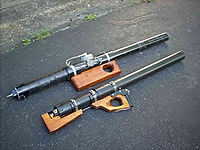Air Cannons
Air cannons are designed to inject blasts of high pressure gas, (up to 10 bars), in a short duration (typically fractions of a second). The shockwave traveling through the bulk solid provides a substantial force to break an arch or a rathole. Air cannons must be located where the stored material can be moved into an empty flow channel. Typical application includes use with sticky, wet, adhesive, fine, caking and fibrous materials. These devices are also used to knock sticky or adhesive materials and residual pockets of material from the walls of a bin/silo.
The force created by discharging air cannons is directly proportional to the reservoir pressure. The duration of the pressure pulse depends on both the size of the reservoir and the initial air pressure.
The blast from air cannons or blasters can be directed either tangentially, (along the wall), or into the bulk material at various angles. Various shapes of nozzles are available to create different dispersion patterns. When operating multiple air cannons, those at the bottom should be fired first, and the other moving progressively upwards at regular intervals. These devices should not be used for continuous operation. They are most useful for restarting flow after long downtime, after a process upset or for terminally clearing the bin after gravity flow has cleared what will discharge of its own accord.
Every blast causes a reactionary force on the silo wall, so reinforcement of walls near the blasters fittings must be considered, especially for retrofit situations. Large chunks of caked or consolidated material may be dislodged from a wall, arch or rathole, to generate significant impact stresses within the silo. The silo and any associated equipment must accommodate such conditions.
Related Video
Source
[1]]
